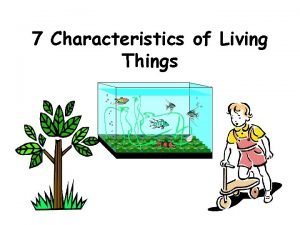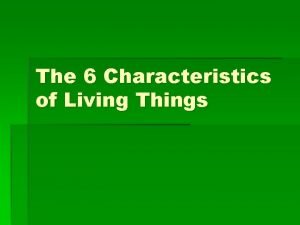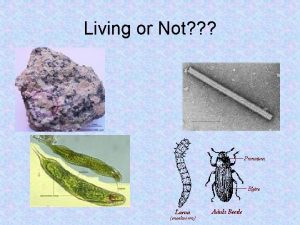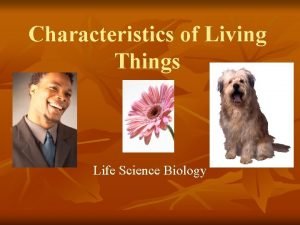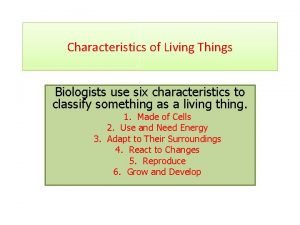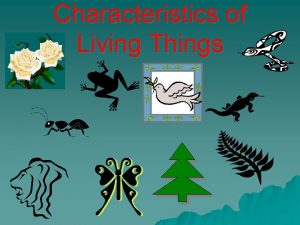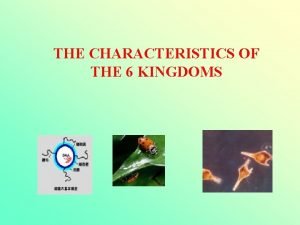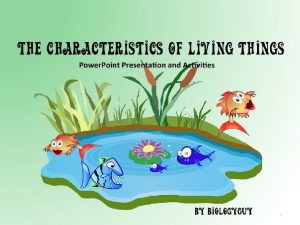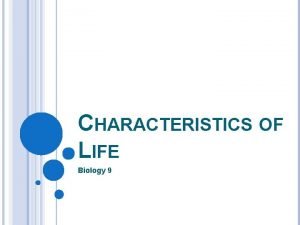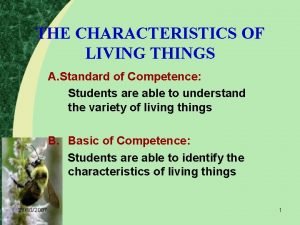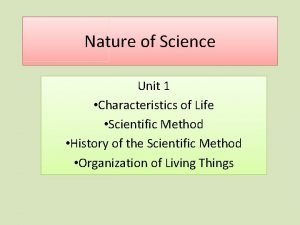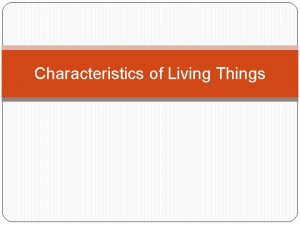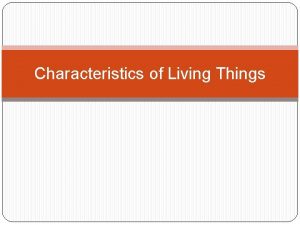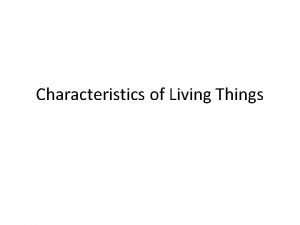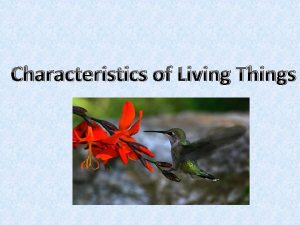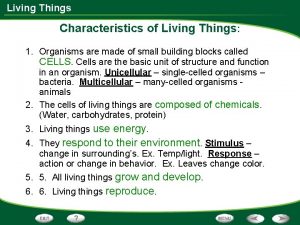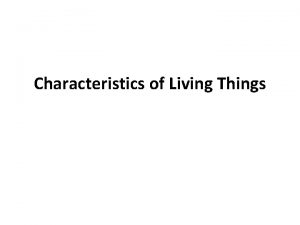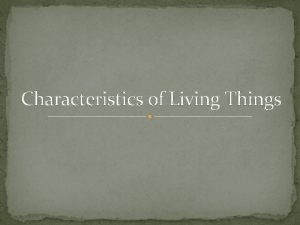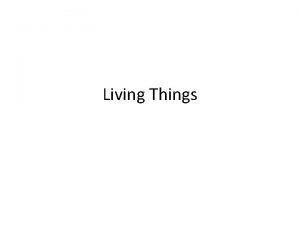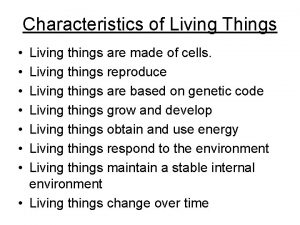Cell Structure Characteristics of Living things Recall characteristics




















- Slides: 20

Cell Structure

Characteristics of Living things… �Recall characteristics of living things. . �(1) Reproduce �(2) Metabolism �(3) Growth �(4) Adjust/Respond to Environment/Stimuli �(5) Organization

Organization – Cell Theory � Robert Hooke first person to examine cells under the microscope – looked at a piece of cork and saw thousands of empty chambers that he called “cells” • Other scientists, like Anton Leeuwenhoek, were also using the microscope to reveal that nonliving things (pond water) contained millions of living things in it!

Properties of Cells � Cells vary in size and shape � Despite their variations, all cells share two characteristics: � (1) surrounded by a barrier called a cell membrane � (2) contain genetic material (DNA)

Two types of cells. . � Two main types of cells (1) Prokaryotes – do NOT contain a nucleus (control center) that houses DNA � (2) Eukaryotes – DO contain a nucleus that houses DNA

Prokaryotes � Greek word that means “before” (pro) “kernel/nucleus”(karyon) � Reflects the idea that prokaryotes are more primitive, older cells that evolved before nuclei developed � No nucleus present � No membrane bound organelles � Unicellular (one cell) � Still considered to be a living thing! Carries out all processes required for survival � Examples include bacteria

Prokaryotes - Plasmid � In prokaryotes the genetic material is not protected in a nucleus. It floats freely in the cytoplasm. � The majority of the genetic material is found in the bacterial chromosome, however a small loop or ring of DNA exists as a plasmid in prokaryotes.

Eukaryotes � Greek word that means “true” (eu) “kernel/nucleus”(karyon) � Reflects the idea that eukaryotes developed after prokaryotes � Nucleus present that contains DNA � Contains membrane bound organelles � Can be unicellular or multicellular (many cells) � More complex internal structures � Examples include plant cells, protists, animal cells, and fungi


�Amoeba Sisters

Recall Homeostasis… �Remember that homeostasis is about maintaining a balance between the environment INSIDE your body and the environment OUTSIDE your body �Structural adaptations have evolved to help animals thrive and assume specialized roles (niches) in even the most extreme of environments

Contractile Vacuoles in Unicellular Organisms � Not all animal cells have vacuoles; some do, and if so they are called contractile vacuoles. Their purpose is to remove excess water build up inside the cell.

Contractile Vacuoles in Unicellular Organsims

Eyespot in Unicellular Organisms � The eyespot apparatus is a photoreceptive organelle found in the flagellate or (motile) cells of green algae and other unicellular photosynthetic organisms such as euglenids. It allows the cells to sense light direction and intensity and respond to it by swimming either towards the light (positive phototaxis) or away from the light (negative phototaxis). Red eyespot

Flagella � Flagella are long whiplike tails used for motion of the cell toward food, away from predators, and for reproduction.

Cilia � Small hairlike projections from the cell membrane used for motion of mucus in respiratory system and movement in unicellular organisms

Cilia are short, hair like appendages extending Definition from the surface of a living cell. Length Found in Flagella are long, threadlike appendages on the surface of a living cell. Short Longer than cilia, can vary Rotational, like a motor, very fast moving Wave-like, undulating, sinusoidal, slow movement compared to cilia Many (hundreds) per cell Few (less than 10) per cell Eukaryotic cells Eukaryotic and prokaryotic cells Motion Density Flagella Pronounced as ‘silly-ah’, is the plural of cilium. Etymology From Latin word for eyelash. Pronounced as ‘fla-gel-ah’, is the plural of flagellum. From Latin word for whip.

Chemotaxis �Chemotaxis is the phenomenon whereby bacteria, and other single-cell or multicellular organisms direct their movements according to certain chemicals in their environment. This is important for bacteria to find food (move to the greatest concentration of particles) or to move away from toxins.

Pseudopod Amoebas use a pseudopod (fake foot) to move toward/away from chemicals

� Phototaxis is a kind of taxis, or locomotory movement, that occurs when a whole organism moves in response to the stimulus of light. This is advantageous for phototrophic organisms as they can orient themselves most efficiently to receive light for photosynthesis. Phototaxis is called positive if the movement is in the direction of increasing light intensity and negative if the direction is opposite.
 Venn diagram living and nonliving things
Venn diagram living and nonliving things Mitochondria information
Mitochondria information Movement
Movement 7 characteristics of living things
7 characteristics of living things Six characteristics of living things
Six characteristics of living things Movement characteristics of living things
Movement characteristics of living things Six characteristics of living things
Six characteristics of living things Six characteristics of living things
Six characteristics of living things Two characteristics of living things
Two characteristics of living things 7 characteristics of life
7 characteristics of life Characteristic of animal kingdom
Characteristic of animal kingdom Mrsgren
Mrsgren Characteristics of animals as living things
Characteristics of animals as living things 8 characteristics of living things
8 characteristics of living things Crawl on a single fleshy pad
Crawl on a single fleshy pad What are the 9 characteristics of life
What are the 9 characteristics of life What is characteristic of living things
What is characteristic of living things What is characteristic of living things
What is characteristic of living things 7 characteristics of living things
7 characteristics of living things Is a candle living or nonliving
Is a candle living or nonliving Living non living dead
Living non living dead



